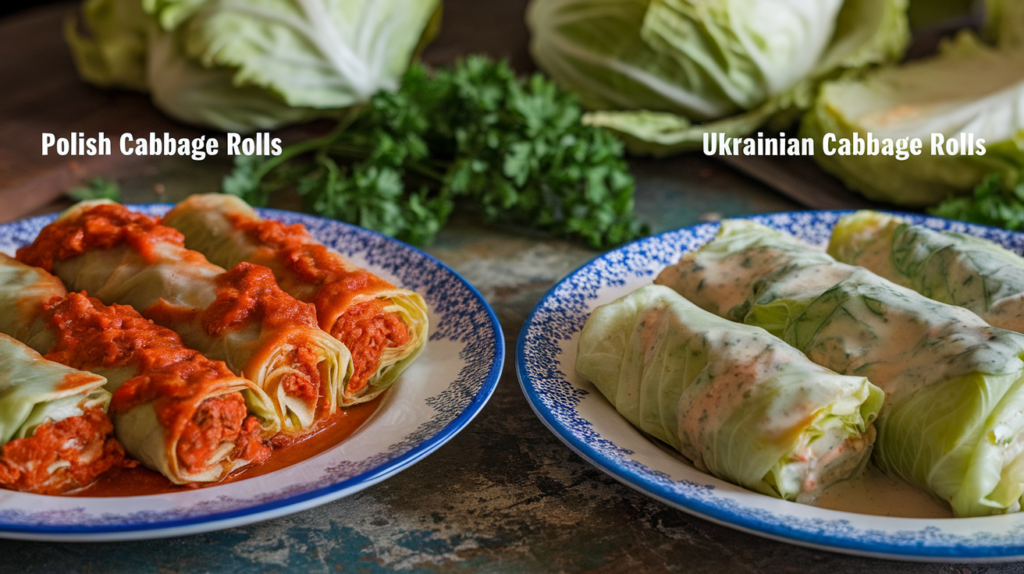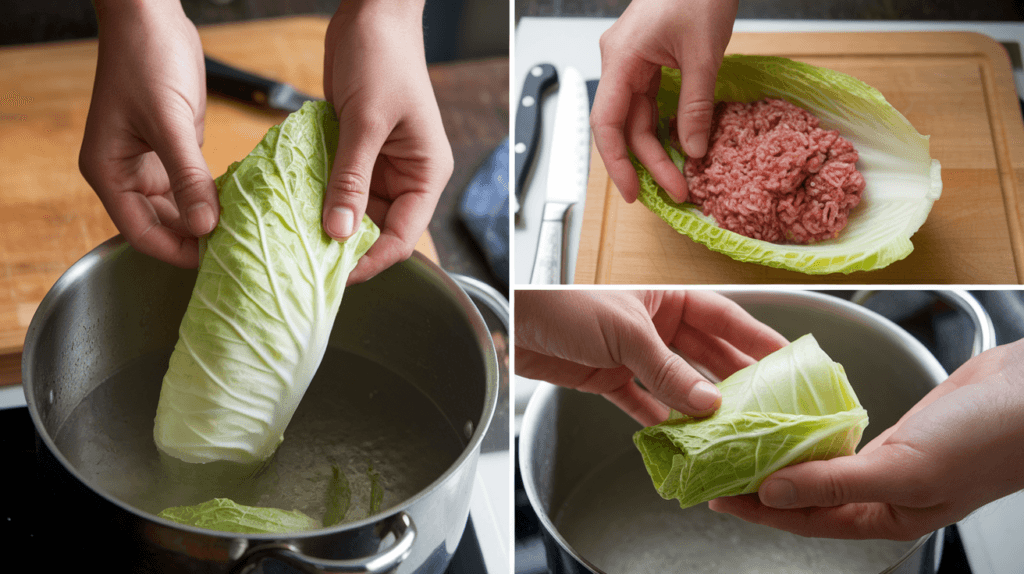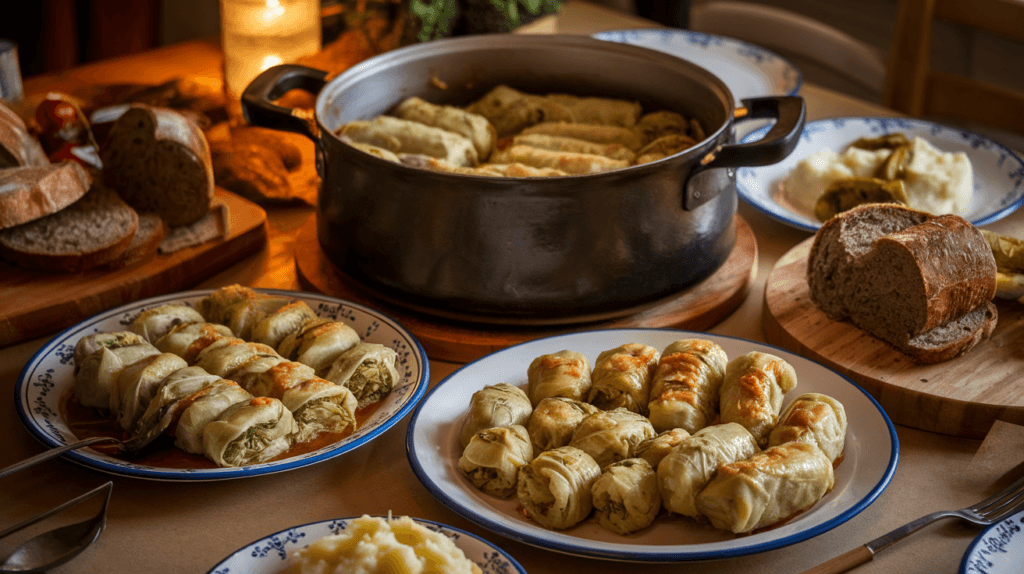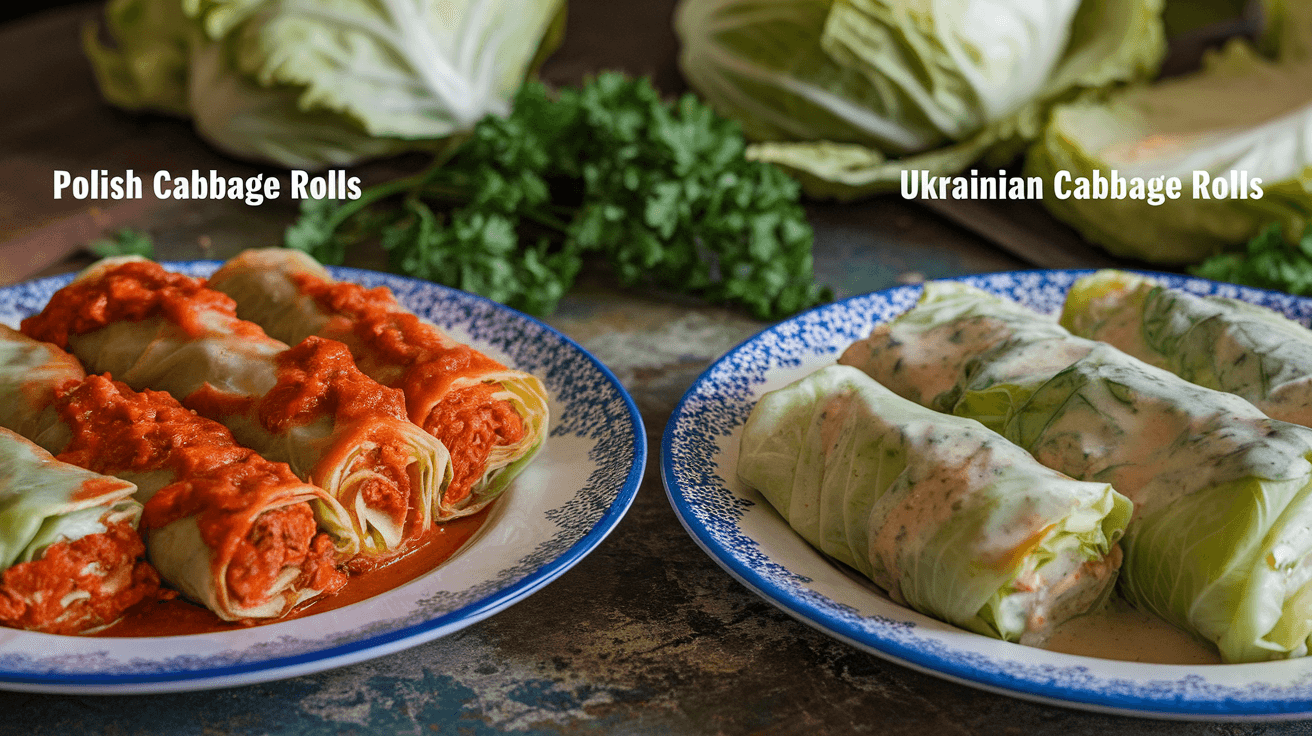Introduction
Cabbage rolls, a beloved staple in Eastern European cuisine, are a culinary treasure that highlights the rich traditions of both Polish and Ukrainian cultures. Though they may appear similar at first glance, the differences in ingredients, preparation methods, and cultural significance set these two versions apart. Exploring the nuances of Polish and Ukrainian cabbage rolls offers a deeper appreciation for their unique characteristics and shared heritage.
In this article, we’ll delve into the key distinctions between Polish and Ukrainian cabbage rolls, tracing their origins, understanding their variations, and examining the cultural factors that influence their preparation. Whether you’re a food enthusiast or someone curious about Eastern European cuisine, this guide will provide a comprehensive look at these delicious dishes.

Origins and Cultural Context of Polish and Ukrainian Cabbage Rolls
Cabbage rolls hold a special place in the culinary traditions of both Poland and Ukraine. These dishes reflect the agricultural heritage and seasonal cooking practices of Eastern Europe, where cabbage is a staple crop and a versatile ingredient in many recipes. Despite their shared regional roots, the cultural significance and evolution of cabbage rolls in each country reveal fascinating differences.
Historical Background of Polish Cabbage Rolls in Cuisine
In Poland, cabbage rolls are known as gołąbki, which translates to “little pigeons.” This name refers to their compact, rolled shape and delicate appearance. The tradition of making gołąbki dates back to medieval times, when the blending of local and foreign influences shaped Polish cuisine. With influences from Germanic, Russian, and Jewish cooking, Polish cabbage rolls often incorporate hearty and simple ingredients like pork, rice, and cabbage, symbolizing the resourcefulness of Polish households.
Historical Background of Ukrainian Cuisine
Ukrainians call cabbage rolls holubtsi, a term that also means “little pigeons.” This dish holds a deep connection to Ukrainian culture, and families often serve it during gatherings and festive occasions. Ukrainian cuisine, shaped by fertile farmlands and Slavic traditions, features ingredients that emphasize freshness and bold flavors. The use of buckwheat instead of rice and the inclusion of tangy or earthy sauces in holubtsi distinguish them from their Polish counterparts.
Importance of Cabbage Rolls in Each Culture
For both Poland and Ukraine, cabbage rolls are more than just a dish—they represent familial bonds, hospitality, and cultural pride. Families often prepare large batches of cabbage rolls for weddings, Christmas, and Easter celebrations. However, the slight variations in their recipes and preparation techniques reflect the distinct regional tastes and customs of each nation, making them unique in their own right.
Key Ingredients of Polish and Ukrainian Cabbage Rolls
One of the most noticeable differences between Polish and Ukrainian cabbage rolls lies in their choice of ingredients. Each cuisine’s unique combination of fillings, spices, and additional components reflects its culinary identity and regional preferences.
Fillings
In Polish cabbage rolls, the filling typically consists of a mixture of minced pork or beef, rice, onions, and occasionally mushrooms. This combination results in a hearty and mildly seasoned dish that focuses on balance and comfort. Rice, often parboiled before mixing, serves as the primary starch, giving Polish gołąbki a soft and cohesive texture.
Ukrainian cabbage rolls, or holubtsi, often feature buckwheat as a substitute for rice, particularly in western Ukraine. This ingredient lends a nutty flavor and firmer texture, distinguishing Ukrainian rolls from their Polish counterparts. Additionally, Ukrainians frequently use a mixture of pork and chicken or even vegetarian fillings, such as mushrooms, potatoes, or millet, showcasing the diversity of their culinary traditions.
Spices and Seasonings
Seasonings in Polish cabbage rolls are relatively simple, with salt, pepper, and sometimes marjoram enhancing the flavor. Polish cuisine generally emphasizes a subtle taste profile, relying on the natural sweetness of the onions and the richness of the meat to shine through.
In contrast, Ukrainian cabbage rolls embrace bolder and more varied spices. Cooks often include dill, garlic, paprika, and bay leaves in the recipe to create a more aromatic and pronounced flavor. These seasonings reflect the vibrant and earthy essence of Ukrainian cooking.
Cooking Fats and Other Additions
Polish cabbage rolls frequently incorporate butter or lard in the preparation process, adding a rich and creamy element. Some regions top cabbage rolls with sour cream, which creates a smooth and indulgent finish.
Ukrainian cabbage rolls, however, lean towards the use of sunflower oil, reflecting the widespread cultivation of sunflowers in the region. This choice of oil imparts a distinct and slightly nutty flavor, complementing the robust ingredients often used in Ukrainian recipes.
The Role of Cabbage
Both Polish and Ukrainian cabbage rolls use white cabbage as the wrapping, but there are slight variations in its preparation. Polish recipes typically blanch the cabbage leaves to soften them, while Ukrainian methods may involve fermenting the cabbage for a tangy twist, especially during winter months when preserved foods are essential.
Preparation Techniques for Polish vs. Ukrainian Cabbage Rolls

While Polish and Ukrainian cabbage rolls share similar steps in their preparation, the techniques employed by each cuisine reveal subtle yet meaningful differences. These variations influence the final texture, flavor, and presentation of the dish.
Cabbage Leaf Preparation
Cooks typically soften cabbage leaves for Polish cabbage rolls by blanching them in boiling water. This method creates pliable leaves that wrap easily without tearing. They often trim or thin the veins of the cabbage to make rolling smoother, reflecting the Polish emphasis on efficiency and practicality in the kitchen.
Ukrainian cabbage rolls may follow a similar process, but there’s an alternative technique: fermenting the cabbage leaves. This method imparts a slightly sour flavor to the rolls and is especially common during colder months when fermented foods are a dietary staple. The tangy flavor adds a distinct depth to Ukrainian holubtsi, setting them apart from their Polish counterparts.
Filling Assembly
Polish cooks typically pre-cook the filling by parboiling the rice and lightly sautéing the meat before mixing it with onions and seasonings. This method creates a uniform texture and reduces cooking time during the final stage. They carefully measure and roll the filling tightly into the cabbage leaves to produce uniform pieces.
Ukrainian fillings, on the other hand, are often raw, particularly when using buckwheat or vegetarian options. This method allows the flavors to meld and develop during the cooking process. The rolls may be slightly looser, reflecting a more rustic and hearty presentation.
Cooking Methods
Cooks traditionally bake Polish cabbage rolls in an oven, layering them with a tomato-based sauce or broth. The slow, even heat of the oven tenderizes the rolls and enhances the tomato sauce’s sweetness. In some regions, families simmer the rolls on the stovetop, especially when preparing larger batches for gatherings.
Cooks often prepare Ukrainian cabbage rolls in a deep pot on the stovetop. They stack the rolls in layers, separating them with shredded cabbage or other vegetables. To cook the dish, they pour broth, water, or a combination of tomato and sour cream sauce over the layers and simmer it gently. This method ensures a moist, flavorful result and is a hallmark of traditional Ukrainian cooking.
Presentation Styles
Cooks typically arrange Polish cabbage rolls neatly on a serving dish and accompany them with a generous ladle of tomato or creamy sauce. The presentation reflects the Polish preference for structured and visually appealing meals.
In contrast, Ukrainian cabbage rolls embrace a more communal style of serving. Cooks often present the rolls in the pot they were cooked in, surrounded by sauce and additional garnishes. This rustic approach underscores the warmth and hospitality of Ukrainian dining traditions.
Sauce Differences in Polish and Ukrainian Cabbage Rolls
The sauce plays a critical role in defining the flavor profile of both Polish and Ukrainian cabbage rolls. While both cuisines rely on sauces to enhance and complement the rolls, their choices and preparation techniques differ significantly, reflecting each culture’s culinary preferences.
Polish Sauces
Cooks often pair Polish cabbage rolls, or gołąbki, with a tomato-based sauce that balances sweet and savory flavors. The sauce typically consists of pureed tomatoes or tomato paste, onions, butter, and sometimes a touch of sugar. This blend creates a smooth and mildly sweet flavor, harmonizing with the subtle seasoning of the rolls.
In some regions of Poland, a creamy tomato sauce is preferred. This variation involves adding sour cream or heavy cream to the tomato base, resulting in a velvety texture and a richer flavor. This creamy sauce not only enhances the dish’s indulgence but also balances the acidity of the tomatoes, offering a comforting and well-rounded taste.
Ukrainian Sauces
Cooks prepare Ukrainian cabbage rolls, or holubtsi, with a wide variety of sauces, showcasing the diverse flavors of Ukrainian cuisine. One popular option includes a tangy tomato sauce made with pureed tomatoes, garlic, and a splash of vinegar or lemon juice. This tangy flavor enhances the rolls’ bold seasonings and highlights their fresh, vibrant elements.
Another common Ukrainian sauce involves a mixture of sour cream and broth, creating a savory and slightly creamy accompaniment. In some cases, the sauce is flavored with dill, paprika, or bay leaves, adding an aromatic complexity. The choice of sauce often depends on the specific region or family tradition, showcasing the adaptability of Ukrainian cooking.
Cooking and Infusion Techniques
In Poland, the sauce is typically poured over the rolls before baking, allowing the flavors to meld during the cooking process. The slow baking process also thickens the sauce, intensifying its sweetness and richness. The final dish often features a generous amount of sauce ladled over each roll for serving.
Cooks in Ukraine pour the sauce into the pot to simmer with the rolls, allowing the flavors to infuse as they cook. They use a layering technique, placing shredded cabbage or vegetables between the rolls to ensure the sauce penetrates every layer. This method creates a dish where the sauce and rolls intertwine deeply, producing a robust and cohesive flavor.
Regional Variations in Sauces
While these general differences exist, it’s worth noting that both Polish and Ukrainian sauces can vary widely based on regional and personal preferences. In northern Poland, for example, a mushroom-based sauce might replace the traditional tomato variant, while some Ukrainian households may opt for a spicier sauce by adding chili or pepper flakes.
These variations highlight the creativity and adaptability of each cuisine, ensuring that no two dishes of cabbage rolls are ever exactly the same.
Serving Traditions of Polish and Ukrainian Cabbage Rolls

The way cabbage rolls are served in Polish and Ukrainian households reflects the cultural values and culinary rituals of each nation. While both cuisines emphasize communal dining and hearty portions, their presentation styles and accompanying dishes vary, adding another layer of distinction.
Polish Serving Traditions
In Poland, cabbage rolls are typically served as a main course, accompanied by simple side dishes that complement their mild and comforting flavors. Mashed potatoes, bread, or boiled potatoes are common sides, providing a starchy base that balances the richness of the rolls and sauce.
Cooks often arrange Polish cabbage rolls neatly on individual plates and top them generously with their signature tomato or creamy tomato sauce. They occasionally add garnishes like fresh parsley or dill to enhance the dish’s visual appeal. During festive occasions, families may present gołąbki in a large serving dish, encouraging diners to help themselves and fostering a sense of togetherness.
Ukrainian Serving Traditions
In Ukraine, cabbage rolls are a staple of family gatherings, particularly during holidays and special celebrations. They are often served in large, communal pots, allowing guests to enjoy the dish straight from the source. This rustic and practical approach reflects the Ukrainian emphasis on warmth and hospitality.
Unlike their Polish counterparts, Ukrainian cabbage rolls are frequently paired with tangy sides like pickled vegetables or fermented cabbage. These sides enhance the dish’s bold flavors and add a refreshing contrast. Freshly baked rye bread is another common accompaniment, perfect for soaking up the savory sauce.
Ceremonial and Festive Roles
Both Polish and Ukrainian cabbage rolls hold symbolic importance during holidays. In Poland, they are a key feature of Christmas Eve dinner, known as Wigilia, a meatless feast where mushroom or vegetarian gołąbki may be served. In Ukraine, holubtsi are a cherished part of Christmas Eve supper (Sviata Vecheria), often prepared with fermented cabbage leaves for extra tang.
Wedding celebrations in both cultures also frequently include cabbage rolls, symbolizing prosperity and unity. The tradition of passing down family recipes ensures that each generation adds its personal touch to these beloved dishes.
The Universal Appeal
Despite their regional differences, the serving traditions of both Polish and Ukrainian cabbage rolls underscore their shared purpose: bringing people together. Whether plated elegantly or served in a communal pot, these dishes remain a testament to the hospitality and culinary artistry of Eastern Europe.
FAQs
Are Polish and Ukrainian cabbage rolls prepared with different types of cabbage?
Yes, while both Polish and Ukrainian cabbage rolls typically use white cabbage, their preparation can differ. Polish recipes often use fresh cabbage leaves blanched to soften them, while Ukrainian recipes sometimes incorporate fermented cabbage for a tangy flavor, especially in winter months.
What are the key differences in fillings between Polish and Ukrainian cabbage rolls?
Polish cabbage rolls commonly use a mixture of minced pork or beef and rice, seasoned lightly with salt and pepper. Ukrainian rolls often feature buckwheat instead of rice and may include more varied fillings, such as mushrooms, millet, or potatoes, alongside meat.
Do the sauces differ significantly between Polish and Ukrainian cabbage rolls?
Yes, Polish cabbage rolls are typically served with a mild, sweet tomato-based or creamy tomato sauce. Ukrainian rolls, on the other hand, feature tangy tomato sauces or sour cream-based sauces, often enhanced with dill, garlic, or other bold seasonings.
Which cooking method is more common: baking or stovetop simmering?
Polish cabbage rolls are traditionally baked in the oven, layered with sauce to achieve a tender texture. Ukrainian cabbage rolls are more commonly simmered on the stovetop in a pot, which allows the sauce to penetrate the rolls deeply.
Are cabbage rolls an everyday dish or reserved for special occasions?
Cabbage rolls can be enjoyed on any occasion, but they hold special significance during holidays and celebrations. Both Polish and Ukrainian households prepare cabbage rolls for Christmas, Easter, and weddings, symbolizing warmth and hospitality.
Can cabbage rolls be made vegetarian?
Yes, vegetarian versions of cabbage rolls are popular in both cuisines. In Poland, mushrooms and rice are common substitutes for meat. In Ukraine, fillings like buckwheat, potatoes, or millet create flavorful vegetarian options that are equally satisfying.
Conclusion
While Polish and Ukrainian cabbage rolls share a common origin and similar cooking methods, their differences highlight the unique culinary traditions of each culture. From the choice of fillings and sauces to the preparation techniques and presentation, both versions reflect the resourcefulness and creativity of Eastern European cuisine.
Polish cabbage rolls emphasize comfort and simplicity, with mild flavors and a creamy, rich texture. Ukrainian cabbage rolls, on the other hand, celebrate bold and tangy flavors, showcasing a rustic and vibrant approach. Both dishes, however, embody the warmth and hospitality of their respective cultures.
Whether you prefer the mild sweetness of Polish gołąbki or the tangy depth of Ukrainian holubtsi, exploring these traditional dishes is a delicious way to experience the rich culinary heritage of Eastern Europe. Why not try making both and enjoy the best of both worlds?

